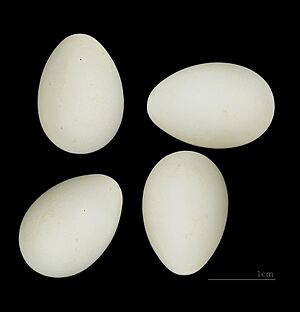Brown-throated martin facts for kids
Quick facts for kids Brown-throated martin |
|
|---|---|
 |
|
| In Natal, South Africa | |
| Conservation status | |
| Scientific classification | |
| Genus: |
Riparia
|
| Species: |
paludicola
|
The brown-throated martin or brown-throated sand martin (Riparia paludicola) is a small passerine bird. It belongs to the swallow family, called Hirundinidae. These birds live in many parts of Africa. They were once believed to be the same species as the grey-throated martin and the Madagascar martin.
Contents
About This Bird
Its Scientific Name
The brown-throated martin was first officially named in 1817. This was done by a French bird expert named Louis Pierre Vieillot. He put it in the group Hirundo. He gave it the scientific name Hirundo paludicola. The second part of its name, paludicola, comes from Latin. It means "marsh-dweller." This is because palus means "swamp" and -cola means "dweller." Vieillot based his description on a bird from South Africa. This bird was described and drawn in 1806 by François Levaillant.
Today, the brown-throated martin is one of six martins in the group Riparia. This group was created in 1817 by a German scientist, Johann Reinhold Forster. As mentioned, it was once thought to be the same as the grey-throated martin (Riparia chinensis) and the Madagascar martin (Riparia cowani).
Different Kinds of Brown-throated Martins
There are six different types, or subspecies, of the brown-throated martin. They look a little different in size. Their feathers can also have slightly different shades of brown on their backs or undersides.
- R. p. mauritanica (Meade-Waldo, 1901) – Found in western Morocco.
- R. p. minor (Cabanis, 1851) – Lives from Senegal and Gambia to northern Ethiopia.
- R. p. schoensis Reichenow, 1920 – Found in central Ethiopia.
- R. p. newtoni Bannerman, 1937 – Lives in northeastern Nigeria and western Cameroon.
- R. p. ducis Reichenow, 1908 – Found in eastern Congo, Uganda, Kenya, and northern and central Tanzania.
- R. p. paludicola (Vieillot, 1817) – Lives from Angola to southern Tanzania and south to South Africa.
What It Looks Like
The brown-throated martin is about 12 cm (5 inches) long. Its back is brown. Its belly and chest are white or light brown. It does not have a dark band across its chest like the sand martin. Its beak is black, and its legs are brown.
Male and female brown-throated martins look very similar. Young birds have light tips on the feathers of their rump and wings.
Sounds It Makes
When these birds are flying, their song is a constant twittering sound. When they settle down to rest, their song becomes a quiet, conversational chatter. They also have a loud, harsh call they use when they are alarmed.
Where It Lives
This bird lives in many places across Africa. Some groups of these birds move to different areas during certain seasons. This means they are a partially migratory species. As its name paludicola suggests, it usually lives very close to water.
How It Behaves
The brown-throated martin has a brown back and is small. Its flight is quicker and more jerky than most other swallows. This helps tell it apart from them. It looks most like the sand martin, Riparia riparia, which lives further north.
Nesting and Babies
Brown-throated martins like to nest in groups, or colonies. Many pairs will build their nests close together if there is enough space. They dig tunnels into sandbanks. These tunnels are usually 30 to 60 cm (12 to 24 inches) long. At the end of the tunnel, there is a chamber. This is where they build their actual nest using straw and feathers.
A female brown-throated martin usually lays two to four white eggs. Both parents take turns sitting on the eggs to keep them warm until they hatch.
What It Eats
These birds mostly eat small insects. They especially like gnats and other flies. The young stages of these insects often live in water.



